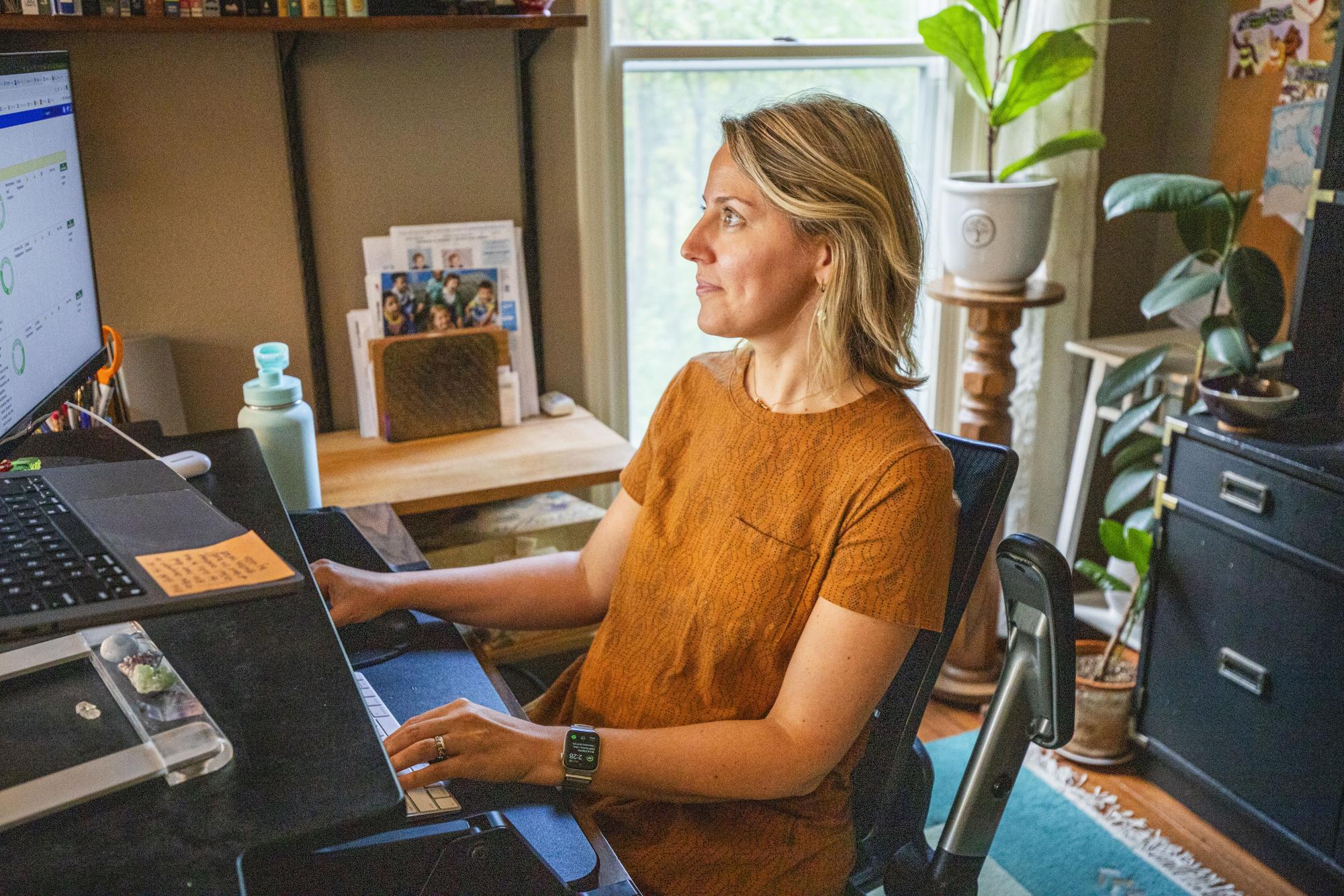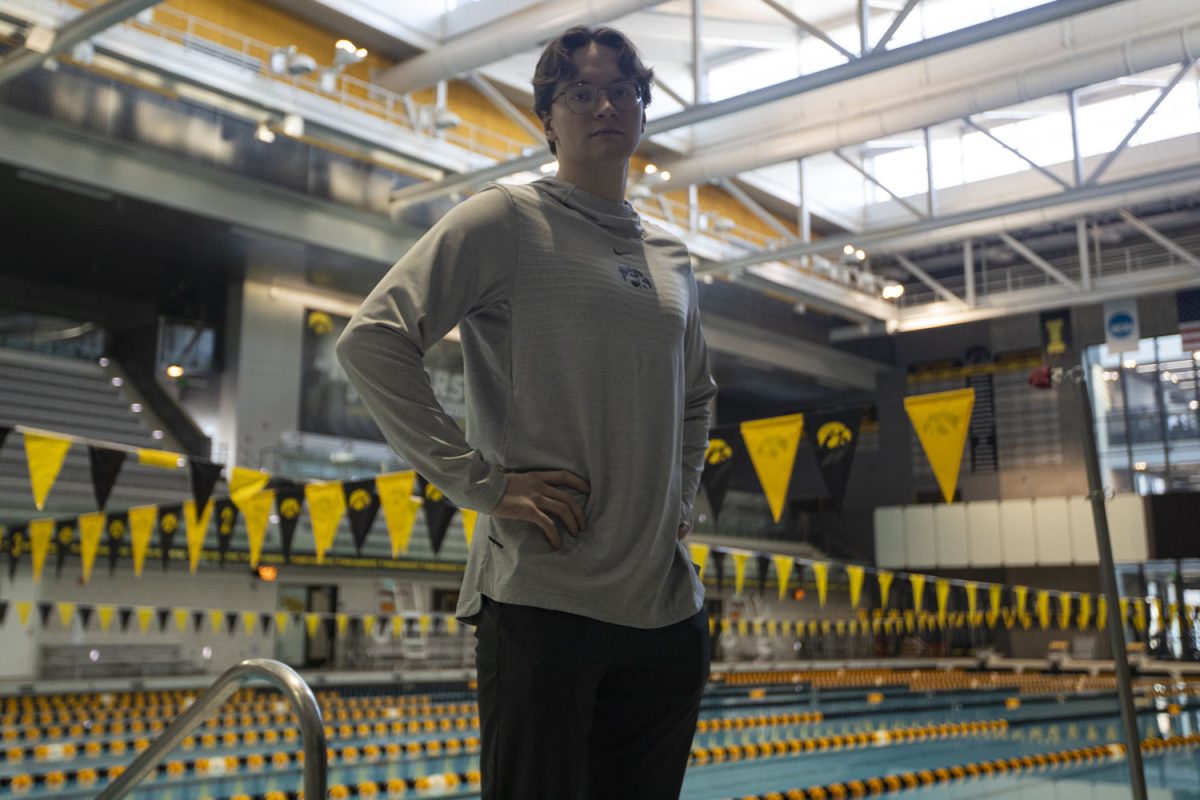Over a decade after graduating from the University of Iowa and The Savannah College of Art and Design, North Liberty resident Gina Whitty carries over $100,000 in student loan debt — over double the average debt of almost $35,000 for the average borrower.
Whitty’s journey with student loans started during the height of the Great Recession. Set to graduate from the UI in 2009 with a Bachelor of Fine Arts in graphic design, the now 36-year-old knew she was not in a place to begin loan payments right away; she said it was nearly impossible to find a job at the time, with her only options being occasional bartending openings or rare freelance design work.
Ben Casselman with The New York Times wrote that 2009 was “the worst job market to graduate into in a generation” with an unemployment rate of nearly 10 percent. That year, Whitty’s future was largely unknown.
So, the Iowa native did what she she felt was her best option: go to graduate school. Moving over 1,000 miles from Iowa to Georgia, she sought a Master of Fine Arts in graphic design at the Savannah College of Art and Design, and in doing so, she said she accured six figures in debt.
“I incurred all this debt in grad school, but I really felt at the time there was no other option,” Whitty said. “I was definitely trying to chase the American Dream in a way and climb the ladder, and just really do what I thought was necessary to pursue a job that I would like.”
Whitty’s story is familiar to nearly 15 percent of the U.S. population who are preparing to begin federal student loan repayments on Oct. 1. When the payments were initially paused, nearly 45 million Americans were student loan borrowers, who are accounted for more than $1.6 trillion in total student debt.
The average student borrower in the U.S. holds $35,210 in student loan debt. In Iowa, about 57 percent of students leave school with student loan debt, averaging $29,350 in debt.
Looking back, Whitty said she definitely didn’t understand how taking out loans would affect her for decades to come.
Whitty managed to stay afloat with various jobs and has found employment since. However, once the COVID-19 pandemic hit, everything changed.
“I have a 5-year-old daughter, and we became pregnant, my husband and I, with what we thought was baby number two in the summer of 2019,” she said. “We found out in December when I was at 22 weeks that it was twins … and then the pandemic hit and heightened it all.”
Her family’s expenses skyrocketed, including groceries and child care. If it wasn’t for the pause on student loan payments in 2020, Whitty says she doesn’t know how her family would have been able to get through the pandemic with new two infants.
“There’s no way I will ever be able to repay the loans in their entirety,” Whitty said.
Resuming payments “is going to be a shock”
Anne Villamil, professor of economics at the UI Tippie College of Business, said the initial pause in student loan repayments in 2020 was much-needed relief for borrowers who lacked financial stability during the early pandemic.
“We had very, very unusual economic activity because we had a very unusual economic shock,” Villamil said. “A side effect of this was inflation. There were massive supply chain problems, and when there are supply chain problems, you have shortages, and when there are shortages … prices go up.”
The shock to the economy in 2020 resulted in lower-income households experiencing losses of income, with more than 60 percent of low-income households with children experiencing an income shock that resulted in “food insecurity and difficulty paying the bills,” according to a study published in the National Library of Medicine.
Villamil said suspending the payments was an effective solution to immediately increase Americans’ incomes during those uncertain times because there was a drop in consumption, and many people could not go to work.
“We had to extend unemployment benefits, we did a lot of other stimulus payments, and it turns out that suspending [those] required payments was a very effective and low-cost way to provide stimulus,” Villamil said.
Louise Seamster, assistant professor in the UI Department of Sociology and Criminology, said she thinks people underestimate the amount of money that’s being discussed when it comes to student loans.
“This pause, in the big picture, allowed people to see a world without student debt, [which is] kind of dangerous to the status quo,” Seamster said. “They could save money, help their family members, donate money to charity, buy houses, they were able to take on different jobs because they weren’t burdened with this.”
Some argue that student loans payments shouldn’t be at the expense of American taxpayers, including Iowa Gov. Kim Reynolds. Reynolds and 21 other U.S. governors sent a letter to President Joe Biden in 2022 voicing concerns about the forgive of student loans.
Seamster has worked on student debt since 2015, conducting academic research that largely contributed to the $50,000 loan forgiveness plan introduced by Sen. Elizabeth Warren’s, D-Mass. In November 2022, she wrote an amicus brief to the U.S. Supreme Court in support of the Biden student loan forgiveness plan.
Leading up to COVID-19, there were already dynamics headed in the direction they are at today, Seamster said. For example, the federal student loan balance increased 267.1 percent since 2006, rising from $480 billion to more than $1.6 trillion in 2023.
COVID-19 only exacerbated the student debt crisis, Seamster said, and not everyone has been able to get back on their feet since the pandemic.
“Sociology shows that when there’s a disaster, it exacerbates inequality that already existed,” she said. “We need to take into account that the people who were least able to repay their student loans before are going to also be the same group of people who are most affected by a pandemic. Whether it’s loss of life, a disability … caretakers in the household losing their job, [or] losing their home.”
Marginalized groups were impacted the most by both the economic shutdown and the student loan crisis.
Seamster’s area of research specializes in how marginalized groups are affected by the cost of higher education. She found that Black households are more likely to hold student debt at most income levels and student debt for Black borrowing households has increased nearly 100 percent in six years.
Twenty years after starting school, the median white borrower had paid off 94 percent of their education debt, while the median Black borrower still owed 95 percent of their debt
Predatory inclusion, the process wherein financial lenders offer services to Black households with exploitative terms, harms long-term benefits for Black people.
Now that payments are resuming, all former college students — especially marginalized groups — are preparing to feel a similar shock to the economy’s shutdown in March 2020.
UI graduates uncertain for what’s to come
For Emily Heinrich, a UI 2022 graduate, she accumulated $19,000 in debt despite receiving the Pell Grant and working multiple jobs as a full-time student. She struggled to find herself in college amid a global pandemic and rising debt.
Heinrich knew when she was looking at colleges in high school that she would have to take out student loans. As one of four children in her household, with two already in college, she was aware her resources were limited.
When Heinrich started her application process for the UI, the amount of financial need was shocking.
“When I got my first financial aid letter back, it was a $36,000 scholarship,” she said. “But I was still going to have to take out $30,000 [per year] in loans, essentially. So at that point, I just didn’t want to have $120,000 in debt.”
After applying to universities, including Iowa, she decided to move to France to accrue less debt during her college career.
“I had to go through the visa process, I had to take all the language tests to make sure that I could pass classes and live there,” she said. “That school was $200 a year. I paid my tuition with my debit card, and that was it.”
After a semester in France, Heinrich said it became too far from home, so she moved back to Iowa. She started out by taking classes at Kirkwood Community College and transferred to the UI to pursue a Bachelor of Arts in political science.
Heinrich graduated from the UI in 2022 and is now a project manager at Johnson County SEATS.
After entering the “real world” post-graduation, Heinrich said there were many emotions as payments neared and the state of loan forgiveness fluctuated.
“When the executive order was first announced, I was so excited,” she said. “I texted my family and friends after I found out. And when that was taken away, I was really, really mad.”
Heinrich initially reached out to The Daily Iowan via email, elaborating more on how she felt about the politics of student loans.
“It is frustrating to see financial relief coming for normal people, and then watch it get taken away for political points by people who will never have to worry about student debt for themselves,” she wrote in the email. “This was a program not for the wealthy, not for the banks, not for crypto investors, but just normal people who worked hard and studied hard to try to get ahead.”
Heinrich now owes $19,000 in student loans, and although she will be able to afford it in the long run, it will be years of discomfort.
First-generation college student Noah Healy graduated from the UI with a bachelor of science in biomedical engineering in 2021 and a master of science in biomedical engineering in 2022. The Frankfort, Illinois, native experienced most of his college years during COVID-19, and it impacted much of his undergraduate goals.
“Everything was online so that pretty much destroyed any motivation that I had to go to school [and] keep up with the work,” the 24-year-old said. “Looking back also, I think I might have changed the way I would have gone about my education. I would have seriously considered going to a community college or finding other ways to save money, knowing where I would be right now.”
When he first signed off on his loans at 18, Healy said he didn’t fully understand what he was getting himself into. As a college student, paying off loans was nothing more than an idea far in the future, and never something to think about, he said. Now $75,000 in debt, Healy said student loans are all he can think about.
“Having to focus on my loans pretty much takes away anything that I could do in regards of saving, putting anything toward retirement, saving up for a wedding or having kids,” he said.
In Healy’s mind right now, it’s “loans, loans, loans,” he said. However, he said it is fortunate he lives in Iowa, a state he says “not many people want to live in” where the cost of living is significantly lower than most states.
“In the space of biomedical engineering, there aren’t too many opportunities in the Midwest unless they’re in major cities like Chicago or Minneapolis, and those cities are considerably more expensive to live in,” he said. “I was lucky enough to find a job here, where cheap housing is somewhat available.”
Healy is now a design engineer at UI Health Care and has enrolled in Biden’s SAVE plan, postponing his payments for the next year.
Moving forward
What comes next for student loan borrowers is largely unknown, especially after three years of unprecedented loan forgiveness proposals and strikedowns, and extended deferred payments.
Villamil said the plans set up for borrowers will help cushion the shock to the economy once payments resume.
“It makes it less likely that a negative economic event would be triggered essentially because it just is a gradual path [for alumni] to get back into the economy,” she said. “It will get people back in the habit of making repayments and finding funding.”






